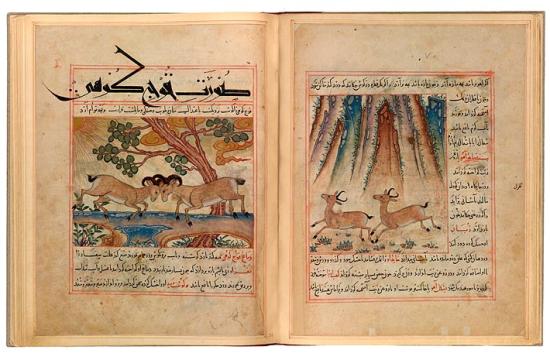
Two Gazelles and Two Mountain Rams
Manāfi˓-i ḥayavān (The Benefits of Animals), in Persian, for Shams al-Dīn Ibn Ẓiyā˒ al-Dīn al-Zūshkī
Purchased by Pierpont Morgan, 1912
Manāfi˓-i ḥayavān (The Benefits of Animals) ranked among the ten greatest Persian manuscripts, dates from the reign of Ghazan Khan (1295–1304), the Mongol ruler who ordered a Persian translation of the book. The Mongol invasion, culminating in the conquest of Baghdad, brought a new, Chinese naturalist style to Persian art. The text discusses the nature and medicinal properties of humans, animals, birds, reptiles, fish, and insects. On the right, two gazelles run in front of a steep, rocky mountainside, kicking up dust (derived from a misunderstood misty landscape model), while on the left two mountain rams fight on a fanciful Chinese-style bridge composed of colored rocks, with gold clouds in the sky.
The manuscript was made at Maragha (south of Tabriz), a center of learning. It was there that Hulagu Khan (r. 1217-1265) built the famous observatory for Nasīr al-Dīn al-Ṭusī, the famous schlar and astronomer.
Natural History and Astrology
The miniatures presented here derive primarily from two extraordinary Islamic manuscripts that depict the natural world and the heavens. The first, Manāfi˓-i hayavān (The Benefits of Animals), is considered one of the ten greatest surviving Persian manuscripts. It dates from the reign of Ghazan Khan (1295–1304), the Mongol ruler who ordered a Persian translation of the book, and concerns the nature and medicinal properties of humans, animals, birds, reptiles, fish, and insects. The other, Matāli˓ al-sa˓āda wa manābi˓ al-siyāda (The Ascension of Propitious Stars and Sources of Sovereign), was commissioned by Sultan Murād III (r. 1574–95), an Ottoman ruler deeply interested in astronomy, cosmology, demonology, poetry, and mysticism.
